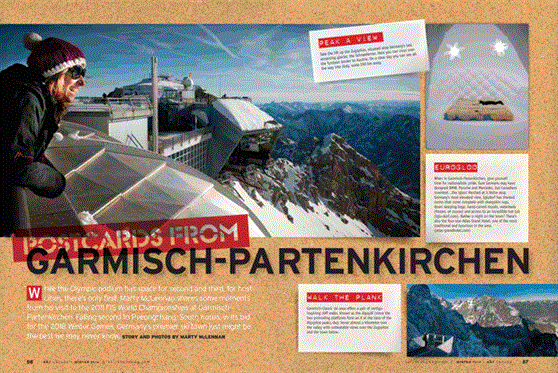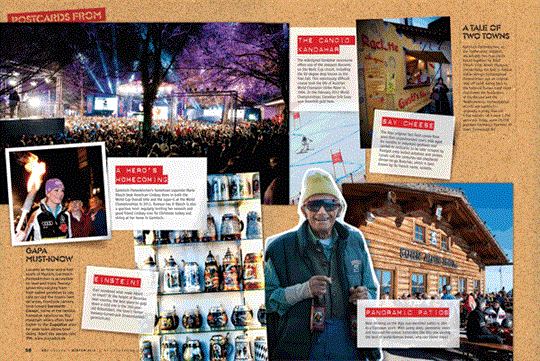While the Olympic podium has space for second and third, for host cities, there’s only first. Marty McLennan shares some moments from his visit to the 2011 FIS World Championships at Garmisch-Partekirchen. Falling second to Pyeongchang, South Korea, in its bid for the 2018 Winter Games, Germany’s premier ski town just might be the best we may never know.
STORY AND PHOTOS BY MARTY MCLENNAN
from Winter 2012 issue
Peak a view
Take the lift up the Zugzpitze, situated atop Germany’s last remaining glacier, the Schneeferner. Here you can cross over the Tyrolean border to Austria. On a clear day you can see all the way into Italy, some 250 km away.
Eurogloo
When in Garmisch-Partenkirchen, give yourself time for nationalistic pride. Sure Germans may have designed BMW, Porsche and Mercedes, but Canadians invented…the igloo! Perched at 2,962m atop Germany’s most elevated view, Igludorf has themed rooms that come complete with sheepskin rugs, down sleeping bags, hand-carved murals, waterbeds (frozen, of course) and access to an incredible hot tub (iglu-dorf.com). Rather a night on the town? There’s also the four-star Atlas Grand Hotel, one of the most traditional and luxurious in the area. (atlas-grandhotel.com)
Walk the plank
Garmisch-Classic ski area offers a pair of vertigo-inspiring cliff walks. Known as the AlpspiX (since the two protruding platforms form an X at the base of the Alpspitze peak), they hover almost a kilometre over the valley with unbeatable views over the Zugspitze and the town below.
A hero’s homecoming
Garmisch-Partenkirchen’s hometown superstar Maria Riesch beat American Lindsey Vonn in both the World Cup Overall title and the super-G at the World Championships in 2011. Rumour has it Riesch is also a gracious host: regularly inviting her nemesis and good friend Lindsey over for Christmas turkey and skiing at her home in Garmisch.
GAPA MUST-KNOW
Located an hour-and-a-half south of Munich Garmisch-Partenkirchen is accessible by road and train. Twenty-seven lifts varying from high-speed gondolas to cog rails service the town’s twin ski areas. Frontside carvers tend toward Garmisch-Classic home of the famous Kandahar racecourse. Big-mountain skiers often head higher to the Zugspitze area for wide-open alpine bowl skiing. Adult day passes cost 39€. www.zugspitze.de
Einstein!
Ever wondered what made Albert so smart? At the height of Bavarian beer country, the best place to gulp down a cold one is the 350-year- old Bräustüberl, the town’s former brewery-turned-pub (braeustueberl- garmisch.de).
The candid Kandahar
The redesigned Kandahar racecourse offers one of the steepest descents on the World Cup circuit, including the 92-degree drop known as the Free Fall. This notoriously difficult course took the life of Austrian
World Champion Ulrike Maier in 1994. In the February 2011 World Championships, Canadian Erik Guay won Downhill gold here.
A TALE OF TWO TOWNS
Garmisch-Partenkirchen, as the hyphenation suggests, are actually two rival towns forced together for Adolf Hitler’s 1936 Winter Olympics (incidentally, the first to feature alpine skiing). Cobblestoned Partenkirchen was an original stop-off point dating back to the Imperial Roman trade route that linked the headwaters of the Danube and the Mediterranean. Archaeological records age Garmisch—originally a pesky Teutonic tribal suburb—at a mere 1,200 years old. Today, some 26,000 populate Germany’s foremost ski town. (www.gapa.de)
Say cheese
The Alps original fast food comes from semi-firm unpasteurized cow’s milk aged for months in mountain grottoes and carried in rucksacks to be later scraped by firelight onto boiled potatoes and pickles. Locals call the centuries-old shepherds’ dinner-to-go Bratchäs, which is best known by its French name, raclette.
Panoramic patios
Beer drinking on the Alps sun-drenched patios is akin to a European sport. With sunny skies, panoramic views and too-cool-for-school bartenders like this one serving the best of world-famous brews, who can blame them?





